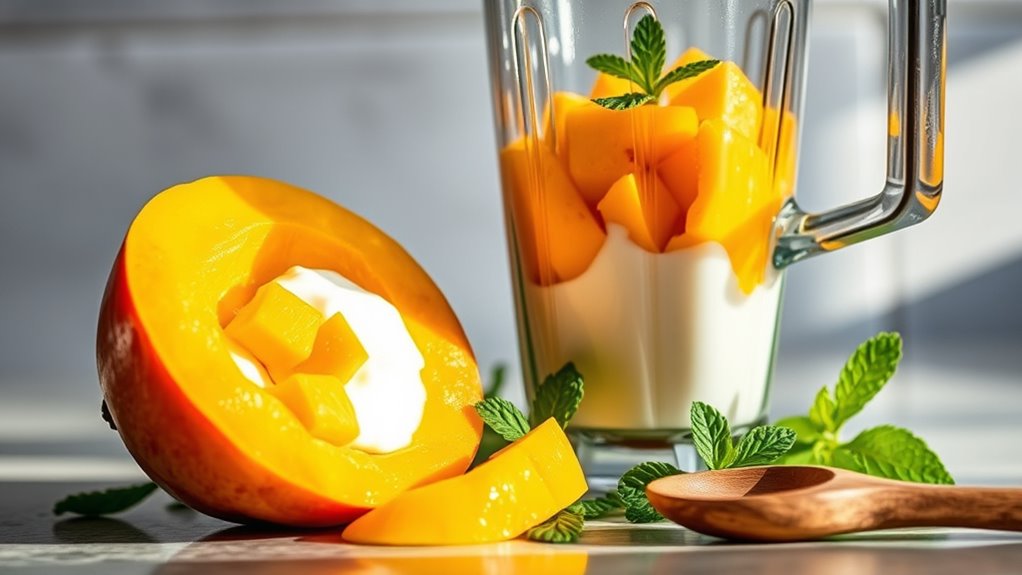You can whip up a wholesome mango smoothie by blending 1 cup of diced ripe mango with ½ cup low-fat yogurt and ¼ cup almond milk. Choose sweet, soft mango varieties like Ataulfo for extra flavor. Blend until smooth, adjusting liquid for your desired thickness. Serve chilled, garnished with mint or chia seeds for a nutritious boost. This quick recipe packs vitamins and aids digestion—keep exploring to discover tips that perfect your smoothie every time.
Ingredients and Quantity

To make one invigorating mango smoothie, you’ll need three main ingredients: ripe mangoes, low-fat yogurt, and a splash of almond milk. Choosing the right mango varieties like Ataulfo or Haden guarantees a naturally sweet, creamy base. If you prefer smoothie alternatives, you can swap yogurt for coconut milk or kefir to suit your dietary freedom.
| Ingredient | Quantity |
|---|---|
| Ripe Mango | 1 cup (diced) |
| Low-Fat Yogurt | ½ cup |
| Almond Milk | ¼ cup (splash) |
This combo keeps your smoothie light, nutritious, and revitalizing. You’re free to adjust the quantities to match your taste and nutritional goals, empowering you to enjoy a healthy, liberating drink anytime.
Preparations

Start by thoroughly washing and peeling one ripe mango, then dice it into small, even pieces to secure a smooth blend. When it comes to mango selection, opt for fruit that yields slightly to gentle pressure—this indicates peak ripeness and maximum sweetness, essential for a flavorful smoothie. Avoid overly firm or bruised mangoes, as they can affect texture and taste. Prepare any additional ingredients like yogurt, milk, or ice separately to maintain control over consistency. If you’re exploring smoothie variations, consider prepping complementary fruits or greens in advance, such as spinach or pineapple. Keeping your prep organized guarantees a quick, nutritious blend, empowering you to enjoy freedom in creating diverse, health-focused mango smoothies tailored to your taste and dietary preferences.
How to Prepare

- Dice the mango into small pieces.
- Choose your liquid base: milk, yogurt, or alternatives like coconut milk, almond milk, or water.
- Consider the texture you want:
- For creamier smoothies, use Greek yogurt or coconut milk.
- For lighter smoothies, use almond milk or water.
- Select the mango variety for desired flavor and texture:
- Alphonso for rich sweetness.
- Ataulfo for smooth, buttery consistency.
- Combine the diced mango and liquid base in a blender.
- Blend on medium speed until smooth.
- Check the thickness:
- Add more liquid if too thick.
- Add more mango or ice if too thin.
- Adjust and blend again as needed to achieve your preferred texture.
- Enjoy a fresh, healthful mango smoothie tailored to your taste and lifestyle.
How to Serve

Once your mango smoothie reaches the perfect consistency, serving it properly enhances both the experience and the nutritional benefits. Choosing the right serving glasses and garnishing options elevates presentation and encourages mindful enjoyment.
- Select chilled serving glasses to keep your smoothie cool longer, preserving its invigorating taste and nutrients.
- Add garnishing options like a sprinkle of chia seeds, a slice of fresh mango, or a mint leaf for texture and antioxidants.
- Serve immediately to maximize the intake of vitamins, especially vitamin C, which diminishes over time when exposed to air.
Tips

Several key tips can help you make the most nutritious and delicious mango smoothie possible. First, experiment with different mango varieties—Alphonso offers rich sweetness, while Ataulfo provides a creamy texture, influencing your smoothie consistency. Choosing ripe mangoes guarantees natural sweetness, reducing the need for added sugars. Next, control your smoothie consistency by adjusting liquid amounts; thicker blends feel indulgent, while thinner ones are easier to sip on the go. Incorporate fresh or frozen fruits for varied texture and nutrition. Avoid over-blending to preserve fiber and avoid warming the smoothie. Finally, use natural sweeteners like honey or dates sparingly to maintain health benefits. By following these tips, you’ll enjoy a revitalizing, nutrient-dense mango smoothie that supports your active, free lifestyle.
Food Value and Benefit
Mango smoothies are not only a delicious tropical treat but also a nutritious beverage packed with essential vitamins and minerals. This prepared dish offers a balanced combination of natural sugars, fiber, vitamins, and minerals that contribute to overall health and well-being.
Food Value of Mango Smoothie:
- Rich in vitamins A and C
- Contains important minerals such as potassium and magnesium
- Provides dietary fiber
- Supplies natural sugars for energy
- Includes protein and calcium when made with yogurt or milk
- Hydrating due to high water content in mango and added liquids
Benefits of Eating Mango Smoothie:
- Boosts Immune System: High vitamin C content enhances immunity and helps protect against infections.
- Supports Eye Health: Vitamin A promotes good vision and healthy skin.
- Improves Digestion: Dietary fiber aids in smooth digestion and prevents constipation.
- Maintains Electrolyte Balance: Potassium helps regulate fluid balance and supports heart health.
- Provides Sustained Energy: Natural sugars combined with protein offer a steady energy release without spikes.
- Promotes Bone Health: Calcium and magnesium contribute to strong bones and muscle function.
- Keeps You Hydrated: The smoothie’s high water content helps maintain hydration levels throughout the day.
